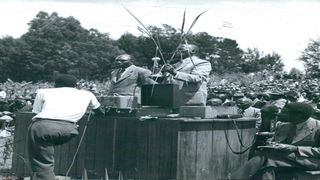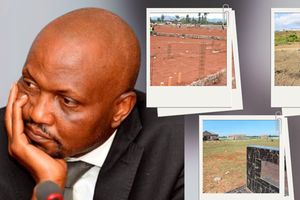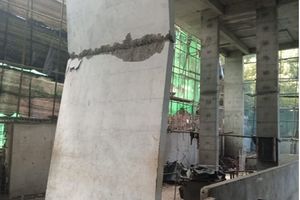
Chief Waruhiu Kung'u speaking in Kiambu on August 24, 1952
| File | Nation Media GroupNews
Premium
How chief’s murder triggered the colonial state of emergency
What you need to know:
- Waruhiu had told the intelligence that he had unearthed a plot where all the white settlers in the colony would be killed by their servants.
- Waruhiu had hatched the idea of starting a loyalist resistance group, which was going to counter efforts by Mau Mau.
It was a Monday, October 6, 1952. Mr Waruhiu Kung’u, a Kikuyu colonial chief, had boarded his Hudson saloon car, together with five other people.
He had been a chief for 30 years and his car showcased power and his love of good things in life. It was luxurious, too. It was his last time at home alive.
Tension had been rising in central Kenya as the shadow of Mau Mau freedom agitation continued to emerge. Waruhiu had told the intelligence that he had unearthed a plot where all the white settlers in the colony would be killed by their servants.
We want our country to be as steady as this pole by having nothing to do with Mau Mau.
Time was running out and on Sunday, August 24, 1952, he convened a leaders rally at Kirigiti Stadium in Kiambu where they would denounce Mau Mau. A record 30,000 people were in attendance, according to police estimates, and riot police from Nairobi had been sent to the stadium, just in case violence broke out.
In attendance were Kenya African Union President Jomo Kenyatta, legislator Eliud Mathu, a radical-turned-moderate Harry Thuku, Senior Chief Josiah Njonjo and ex-Senior chief Koinange wa Mbiyu.
It was Waruhiu who set the political tempo for the rally: “We want our country to be as steady as this pole by having nothing to do with Mau Mau.” It was during this meeting that Kenyatta made the controversial statement about Mau Mau, asking them to disappear like Mikongoe tree roots. But was Kenyatta denouncing Mau Mau or simply urging them to go farther underground? The director of African Information Service, John Henry Reiss, had sent his team with cameras and microphones to record the rally – an intelligence gathering exercise.
Self-government
So tense was this meeting that when Njonjo, the father to future Attorney-General Charles Njonjo, said Africans were not ready for self-government, which was KAU’s demand, he was booed. Chief Njonjo was saved by Kenyatta who asked the crowd, then walking away, to exercise restraint.
But it was Kenyatta and Waruhiu who paid differently for their statements after the Kirigiti rally – Kenyatta with a seven-year jail term, by the colonial government, and Waruhiu, with death.
Waruhiu had hatched the idea of starting a loyalist resistance group, which was going to counter efforts by Mau Mau, a direct threat to his leadership, and also he had never faced any such resistance as he spewed his influence within the region.
After the Kirigiti rally, somebody sneaked into Waruhiu’s homestead and burnt the house of his fifth wife. Whoever did it, in the dark of the night, had hoped to get Waruhiu who had become the symbol of anti-Mau Mau rhetoric. Anonymous letters were dropped in his compound warning him to steer clear the Mau Mau question. He didn’t.
Kapenguria Six trials
Waruhiu had reported to local District Commissioner Noel Frederick Kennaway that his life was in danger. Kennaway, who featured in the Kapenguria Six trials, was said to have asked Kenyatta to put denunciation of Mau Mau in his rallies, but Kenyatta refused or according Kennaway “he gave excuses”. In June 1952, Kenyatta had told a mammoth rally in Thika, perhaps with tongue-in-cheek, that he did not know Mau Mau. But then he added with a Kikuyu idiom; reke andu manyue kabaki kanini (‘let the people take a little snuff).” The meaning of this phrase escaped even the colonial translators and its featured prominently in Kapenguria since the statement was followed by a thunderous applause from the crowd.
Kennaway had proposed to give Waruhiu an armed bodyguard but this would have become an indicator that the chief was fearing his own people – and more so, given Mau Mau the impression that they had at least scared the chief. It was this time that Waruhiu was given a .38 Smith and Wesson revolver for self-protection, which was handed to him by Kiambu police boss, Alistair John Allen.
Let me go, if I come back, well and good, if I don’t, that is it
All along, Chief Waruhiu knew he was a wanted man. He stopped meeting strangers and occasionally he would take refuge in settlers’ homes, in Ngorongo and Cianda, hoping that Mau Mau would be vanquished before they caught up with him.
On that Monday, Chief Waruhiu had been asked by the District Commissioner to appear as a witness in a long-running land case involving the Kihara clan, who inhabited current Kihara location in Kiambu. Despite pleas by his wives not to attend, Waruhiu refused to bulge telling his fifth wife, Ruguru : “Let me go, if I come back, well and good, if I don’t, that is it.”
Tension was still rising. He took his new gun and was accompanied by five other people. The case did not commence, due to a missing file, and he spent that night in Gachie village.
The case commenced the following day and Chief Waruhiu addressed a meeting there warning Kikuyu that if they did not heed his warnings, calamity would befall them. It was one o’clock when he left Gachie with four people including businessman Kiburi wa Thumbi, the man who had organised various firewood and timber merchants to form one of the pioneer limited liability companies and which had purchased Kiburi House – the headquarters of Mau Mau war council in Nairobi.
Perhaps, Waruhiu did not know that Kiburi House was now being used by Mau Mau. By then Kiburi was the President of Githunguri Tribunal Court and sat in the front seat while Chief Waruhiu was at the back seat.
Ford Consul
Along the way, a fawn coloured Ford Consul was hidden near a wattle plantation and they started following Chief Waruhiu’s car at great speed. “You have your gun?” Kiburi asked the chief. He had, but did not withdraw it. It was still wrapped in a paper bag on the front seat pocket. They drove on.
The road was narrow, and it made it hard for the Ford Consul to overtake Waruhiu’s car. It hooted, to be allowed to overtake but Waruhiu instructed the driver not to. But upon reaching a wide road, the Ford Consul overtook Waruhiu and as the road narrowed again, it stopped and seemed to reverse. Waruhiu sat still watching the car.
Witnesses later told the court that a light-skinned man, in a jovial mood, emerged from the car. He wore a dark brown tarpaulin jacket, and had a red and white spotted scarf and khaki trousers. He then unzipped the jacket which gave Waruhiu the impression that he was handing in a letter.
“Yes, Senior Chief Waruhiu,” the man said. Before Waruhiu could answer, the man produced a .38 Smith and Wesson gun and shot Waruhiu five times. He died instantly. He then punctured the front tyre and walked back to the car and vanished.
Police from Muthaiga Police Station, where the murder was recorded, described the killing as “a murder in the best Chicago style” as the government sent Assistant Commissioner of Police and Criminal Investigation Department boss John Timmerman to start investigations.
It was now clear that Mau Mau would not only target the white settlers but also the sympathisers. But it was the expansive Kihara family which would earn the wrath of the government and were detained in new barbed-wire enclosures after all the holding cells were full. A reward of Sh10,000 was offered to anyone who could identify the murderer. Nobody volunteered.
For the new governor, Sir Everlyn Baring, who was hardly five days in Kenya, this was a signal that the country was on the verge of an implosion.
Waruhiu was widely known and a memorial service was also held at the Moral Rearmament Assembly in Geneva, where his son David was attending a seminar.
On Thursday, October 9, 1952 about 1,000 mourners, with police on standby, gathered at Waruhiu’s farm in Kiambu for a funeral service. His coffin was draped with the Union Jack flag – an indicator that he was a respected administrator.
“Chief Waruhiu was a great Kikuyu. He was a great African and a great citizen of Kenya. He had spent his life – and he had met his death – in the service of God, his people and his Government. His was a faithful service,” said the Governor.
After the gun salute, the police band played the Last Post bugle call , normally used in military funerals to celebrate those killed at war. Jomo Kenyatta was there, watching the events unfold.
Freedom fighters
Looking back, this was the first signal that Kenya was now entering a war phase against the freedom fighters.
After the funeral, a 7pm to 5.30 am curfew was imposed on Kiambu and adjacent areas and 11 days later, a State of Emergency was declared in the whole country. The death of Waruhiu stunned the government, which had underestimated the Mau Mau – or what Baring called a planned revolutionary movement.
On October 14, 1952, the Secretary of State for Colonies allowed the governor to impose a state of emergency. A week later, Jomo Kenyatta, Fred Kubai, Achieng Oneko, Bildad Kaggia and other KAU stalwarts were arrested.
Elsewhere, fingers were pointed to the wealthy Senior Chief Koinange, a known Mau Mau supporter, and who had fallen out with Waruhiu. It was known that Waruhiu did not approve Koinange’s involvement with independent schools and Waruhiu had always wanted to upstage Koinange who retired in 1949. The arrest of Koinange, and his son, John Wesley Mbiyu as one of the murderers saw Koinange hire a Queen’s Counsel, Dingle Foot to represent him and his son, while Jamaican Dudley Thompson, who later represented Kenyatta, appeared for the rest.
The death of Waruhiu was a turning point and all fingers were pointed towards Mau Mau Central Committee, Muhimu, which was determined to stop Waruhiu and kick start the liberation struggle. Waruhiu was indeed standing on that path and to Mau Mau, he was a traitor. After that, thousands paid with their lives too.
[email protected]; @johnkamau1





